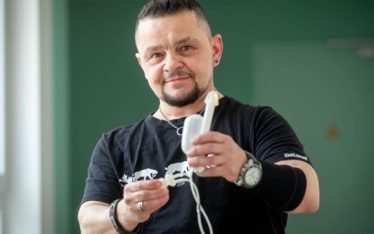
A few weeks ago we told you about a patient with a phalloplasty which required two replacement surgeries and the reconstruction of the glans. I (Blanche) had the pleasure of interviewing a patient treated by Dr. Daverio (from Switzerland), to learn about the patient’s history and his daily life with a ZSI implant specifically designed for the anatomy of FTM patients. We touched on numerous subjects that are common areas of concern for patients interested in our implants. I hope you will find answers here to some of your questions.
Background (the complete original article can be found here):
The patient initially had an AMS implant. That was removed and replaced with a ZSI 475 FTM implant of 15 cm. But this implant ended up being too short and produced a sensation of flaccidity in the glans due to an excess of skin. The patient and the surgeon understood going in that this was a possibility—at that time the 18 cm ZSI 475 FTM implant was not available, so the 15 cm implant seemed the best option. A few months later, the 15 cm implant was replaced with the 18 cm ZSI 475 FTM implant, which could expand correctly to fill out the whole phalloplasty. Several infections occurred, first a week after the device was first deflated, and then after the patient’s first sexual relations with penetration. The infections started in the scrotum and ascended into the phallus. These infections were successfully treated with antibiotics.
Appearance:
Now that an implant of appropriate size has been fitted and the glans has been created, the neophallus has a satisfactory appearance. Because the skin from the donor site (the right forearm) was very thin, the patient experienced a small excess of skin, which was easily corrected by the placement of the larger implant.
Use:
The pump for the ZSI 475 FTM implant is quite small compared to the AMS device. When inserted into the scrotum, it does not cause deformation. However, it requires considerable force to squeeze it, and it would be better if it were larger. The patient feels that the phalloplasty is insufficiently rigid once the implant is inflated. (Note: the implant should be inflated until one feels a small click, which indicates it has reached its maximum.) The pump is small, and the button to deflate it can be difficult to locate (it’s on the side, close to the thigh). Once it is located, the deflation is completed easily.
Sexual relations:
The presence of the glans is pleasing and even allows penetration without inflating the implant. The patient did not undergo a metoidioplasty—Dr. Daverio performed the phalloplasty in a single stage. The majority of sensation is produced in the glans. According to the patient, the couple is quite happy with this new implant and with the sensations generated during the sexual act.
After the operation:
Three months after having the operation, the patient is happy and quite satisfied with the new device. The post-operative infections (not uncommon) were controlled and reabsorbed, and they did not pose a threat to the phalloplasty. Specifically designed for FTM individuals, the ZSI 475 FTM implant does not move within the neophallus because it is securely attached (sewn) to the pubic bone. The angle of the erection, which depends on the morphology, is not as important as the patient would have thought. He told me he supports the Swiss FTM community and always recommends ZSI for its products, for its availability, and also for its personalized followup with patients.
It makes us very happy when patients are satisfied in this way! Thank you for your time. Congratulations and best wishes for your future marriage!
ZSI is the only European manufacturer of artificial urinary sphincters and of malleable and inflatable penile implants, as solutions for male urological problems (incontinence), sexual complications (Erectile Dysfunction), and gender identity procedures (prostheses for trans men and women).






